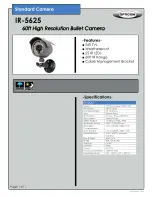
Page 13 of 50
KNX presence detector PlanoCentro A-KNX
Object
Object name
Function
Description
Object 19
M channel room
monitoring
Message
Objects 19 - 22 available if 'active..' has been selected on <M channel room monito-
ring>.
Depending on the configuration, the presence detector sends the motion information via
object 19 with increased security against faulty activation:
<Report type>: Switching (On/Off): On detection of movement, the monitoring channel
sends an ON telegram and an OFF telegram after expiry of the monitoring switch-off
delay.
<Report type>: Cyclic with confirmation: The monitoring channel sends an ON telegram
on detection of movement. The detector sends another ON telegram if the telegram is
not confirmed on object 20 within the configured waiting time. This process is repeated
until a confirmation is received.
Object 20
M channel room
monitoring
Confirmation
If the monitoring channel is configured to "cyclic with confirmation", the detector
expects a 0 or 1 telegram on object 20. It resends the ON telegram in cyclical intervals
providing there is no confirmation.
Object 21
M channel room
monitoring
Sabotage
cyclically
In order to identify the dismantling of the presence detector, object 21 continuously
sends OFF telegrams as long as the detector is operating.
Object 22
M channel room
monitoring
Enable
The M channel room monitoring can be enabled with an ON telegram on object 22 or
disabled with an OFF telegram in both <Report types> during operation. No telegrams
are sent via the reporting object (19) while disabled. Once enabled, the detector sends
its current status via object 19.
Object 23
Parallel connection
Trigger
input/output
Object available if 'parallel connection' has been selected at <Master operating mode>.
Trigger input/output is required for the parallel connection of more than one presence
detector. In configuring the detector, it is only visible as a "Master in parallel connec
-
tion" or as a "Slave". There are two possible types of switching:
Master/Slave parallel connection: A Master receives the movement information from se-
veral Slaves in the room and switches or controls the lighting as required. The advantage
is uniform switching with a defined brightness value. For applications in corridors for
example, the Master is installed in the darkest position.
Master/Master parallel connection: Several Masters exchange movement informati-
on. The advantage is a zone with uniform presence detection but with several light
measurements, for example 3 lighting groups in a room, where the group nearest to
the window can be dimmed much darker than the lighting groups in the interior of the
room.
Each detector sends a maximum of two ON telegrams per minute on detection of move-
ment. The interval (cycle time) between two telegrams can be set to a maximum of four
minutes. Please note, the interval between two trigger telegrams is always shorter than
the switch-off delay times.
See information on parallel connection on page 29 chapter 4
Object 24
Input/output scene
Depending on the chosen configuration, internal scenes can be called up via object 24,
scenes can be directly controlled or via an external scene component controlled.
Scenes 1/2
internal scenes: Object 24 becomes the "input scene" if "internal scenes" is selected in
<Scene control>.
An OFF telegram to the scene input object calls up scene 1, an ON telegram calls up
scene 2.
Scene component: Object 24 becomes the 'output scene' if "scene component" is
selected in <Scene control>.
By pressing scene push button 1 on the user remote control, the scene output object
sends an OFF telegram and pressing scene push button 2 sends an ON telegram.
Scene number
Object 24 becomes the "output scene" if "send scene" is selected in <Scene control>.
By pressing the scene push buttons on the remote control, the scene output object
sends the selected scene number.













































